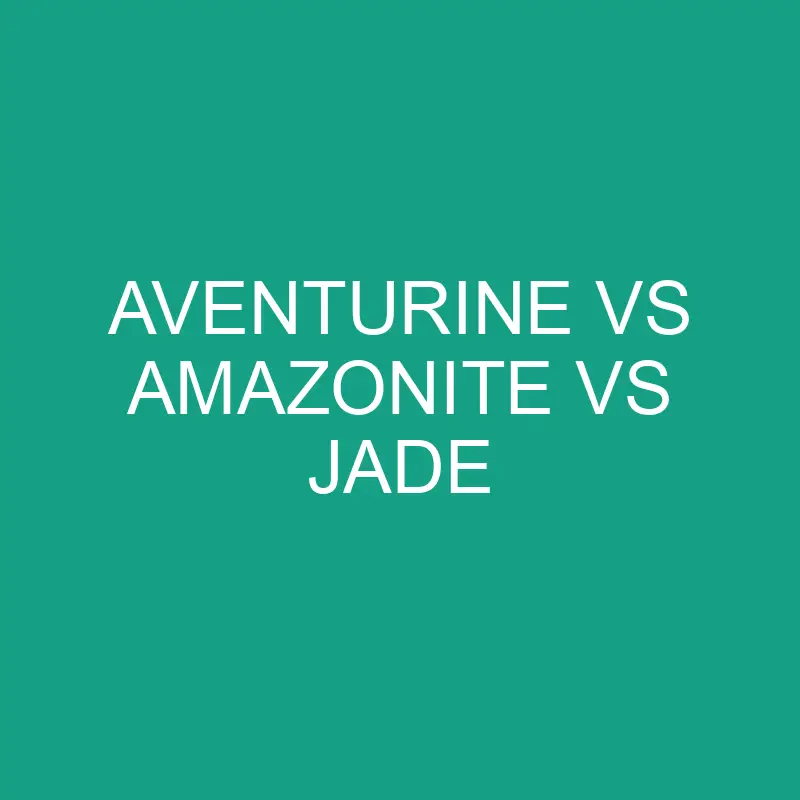Aventurine, Amazonite, and Jade are distinct gemstones, each with its unique characteristics, colors, and cultural significances. Let’s explore the differences between Aventurine, Amazonite, and Jade.
Post Contents
Aventurine:
Origins and Geology:
- Origins: Aventurine is a form of quartz known for its sparkly inclusions, typically composed of fuchsite or hematite. It is found in various locations, including India, Brazil, and Russia.
Physical Properties:
- Color: Aventurine comes in a variety of colors, including green, blue, orange, and brown. Green Aventurine is the most common and popular.
- Inclusions: It is recognized by its shimmering metallic inclusions, known as aventurescence.
- Transparency: Generally translucent to opaque.
- Mohs Scale: Aventurine has a hardness of 6.5 to 7 on the Mohs scale.
Uses:
- Jewelry: Aventurine is commonly used in jewelry, including beads, cabochons, and carvings.
- Ornamental Items: It is also used in decorative items like vases, bowls, and figurines.
Metaphysical Properties:
- Luck and Prosperity: Aventurine is often associated with luck, prosperity, and well-being.
- Heart Chakra: It is believed to be a stone of the heart chakra, promoting emotional healing and balance.
Amazonite:
Origins and Geology:
- Origins: Amazonite is a green to blue-green variety of microcline feldspar. It is named after the Amazon River but is not found in the Amazon rainforest. Major sources include Russia, Brazil, and the United States.
Physical Properties:
- Color: Typically green to blue-green, with variations in intensity.
- Transparency: Usually translucent to opaque.
- Mohs Scale: Amazonite has a hardness of 6 to 6.5 on the Mohs scale.
Uses:
- Jewelry: Amazonite is popular in jewelry, often used in beads, cabochons, and pendants.
- Carvings: It is also used in carved items and sculptures.
Metaphysical Properties:
- Communication: Amazonite is associated with communication, soothing energies, and balance.
- Throat Chakra: It is believed to align with the throat chakra, aiding in self-expression.
Jade:
Origins and Geology:
- Origins: Jade is an ornamental rock composed of two minerals: jadeite and nephrite. It has been historically significant in Chinese, Mayan, and Maori cultures. Jadeite jade is found in Myanmar, while nephrite jade is found in various locations, including China, Canada, and Russia.
Physical Properties:
- Color: Comes in a range of colors, including green, white, lavender, yellow, and black.
- Transparency: Translucent to opaque.
- Mohs Scale: Jadeite jade is harder, with a Mohs hardness of 6.5 to 7, compared to nephrite jade, which is softer, with a Mohs hardness of 6 to 6.5.
Uses:
- Jewelry: Jade has been historically used for jewelry and carvings, especially in East Asian cultures.
- Cultural Artifacts: In many cultures, jade has significant cultural and spiritual importance and is used in the creation of artifacts, sculptures, and ceremonial items.
Metaphysical Properties:
- Harmony and Protection: Jade is often associated with harmony, balance, and protection.
- Heart Chakra: It is believed to align with the heart chakra, promoting love and emotional well-being.
Comparative Analysis: Aventurine vs. Amazonite vs. Jade
Color:
- Aventurine: Various colors, with green being the most common.
- Amazonite: Green to blue-green.
- Jade: Various colors, including green, white, lavender, yellow, and black.
Inclusions:
- Aventurine: Exhibits aventurescence, a shimmering effect due to inclusions.
- Amazonite: Generally free of notable inclusions.
- Jade: May have inclusions but is often appreciated for its pure color.
Transparency:
- Aventurine: Translucent to opaque.
- Amazonite: Translucent to opaque.
- Jade: Translucent to opaque.
Mohs Scale:
- Aventurine: 6.5 to 7.
- Amazonite: 6 to 6.5.
- Jade: Jadeite jade has a hardness of 6.5 to 7; nephrite jade has a hardness of 6 to 6.5.
Cultural Significance:
- Aventurine: Generally less culturally significant compared to Amazonite and Jade.
- Amazonite: Holds some cultural significance and historical use.
- Jade: Highly significant in various cultures, especially in China, where it’s considered a symbol of purity and grace.
Metaphysical Associations:
- Aventurine: Associated with luck, prosperity, and the heart chakra.
- Amazonite: Linked to communication, soothing energies, and the throat chakra.
- Jade: Associated with harmony, protection, and the heart chakra.
Conclusion: Choosing the Right Gemstone for You
Choosing between Aventurine, Amazonite, and Jade depends on your personal preferences, the metaphysical properties you resonate with, and the cultural significance you value. If you are drawn to luck and prosperity, Aventurine might be a good choice. For those seeking a stone linked to communication and soothing energies, Amazonite could be suitable. Jade, with its rich cultural history and associations with harmony, might be the ideal choice if you appreciate the cultural and spiritual aspects of gemstones. Ultimately, the choice is a deeply personal one, guided by your preferences and the energies you seek from these beautiful gemstones.
